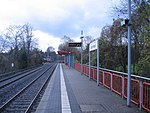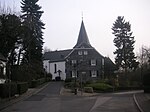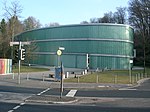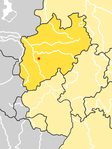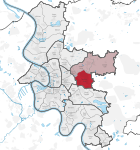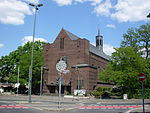The Neandertal (, also US: , German: [neˈʔandɐtaːl]; sometimes called "the Neander Valley" in English) is a small valley of the river Düssel in the German state of North Rhine-Westphalia, located about 12 km (7.5 mi) east of Düsseldorf, the capital city of North Rhine-Westphalia. The valley lies within the limits of the towns of Erkrath and Mettmann. In August, 1856, the area became famous for the discovery of Neanderthal 1, one of the first specimens of Homo neanderthalensis to be found.
The Neandertal was originally a limestone canyon widely known for its rugged scenery, waterfalls and caves. However, industrial quarrying during the 19th and 20th centuries removed most of the limestone and dramatically changed the shape of the valley. It was during such a quarrying operation that the bones of the original Neanderthal man were found in a cave known as Kleine Feldhofer Grotte. Neither the cave nor the cliff in which the bones were located still exist.
During the 19th century, the valley was called Neanderhöhle (Neander's Cave) and, after 1850, Neanderthal. It was named after Joachim Neander, a 17th-century German pastor. Neander is the Graeco-Roman translation of his family name Neumann; both names mean "new man". Neumann lived in nearby Düsseldorf and loved the valley for giving him the inspiration for his compositions. Former names of the gorge were Das Gestein (The Boulders) and Das Hundsklipp (Cliff of dogs, perhaps in the sense of "Cliff of Beasts").
In 1901, an orthographic reform in Germany changed the spelling of Thal (valley) to Tal. Scientific names, such as Homo neanderthalensis and Homo sapiens neanderthalensis for Neanderthal remained unchanged, because the laws of taxonomy retain the original spelling at the time of naming. However, Neanderthal station never changed its name to conform with the new German orthography and the modern Neanderthal Museum retains the original spelling.

